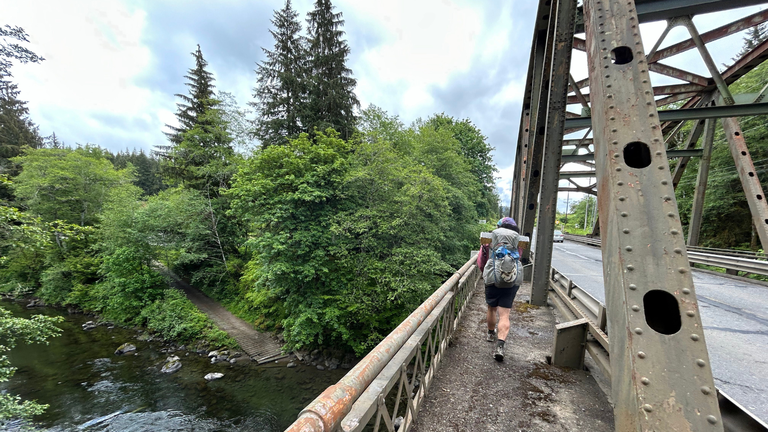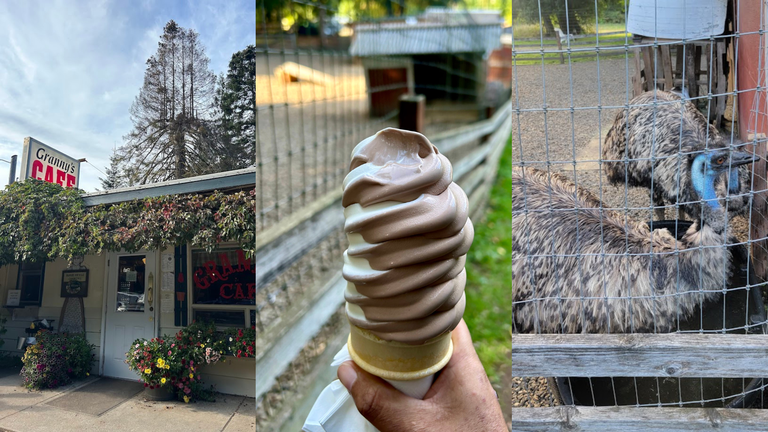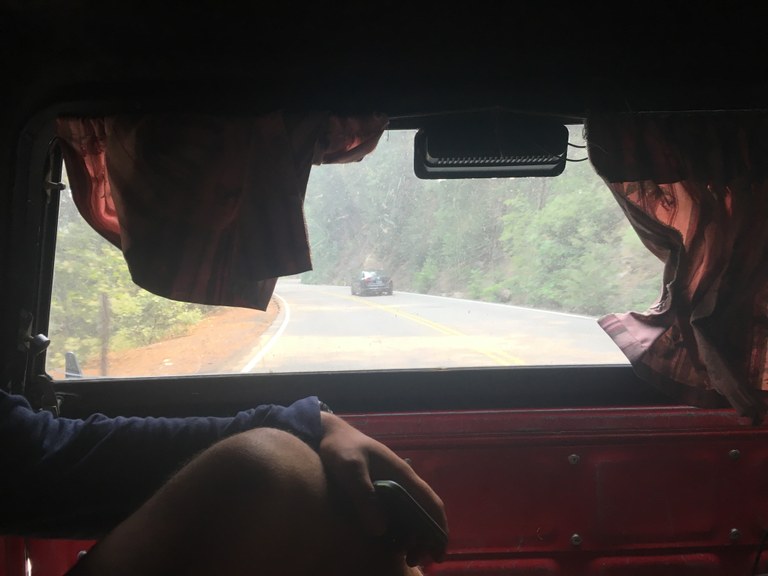 Washington Trails
Association
Washington Trails
Association
Trails for everyone, forever
If you enjoy long backcountry thru-hikes like me, you’re eventually going to hitchhike. Here are some recollections from my many hitchhikes and how they brought me closer to trails. By Joseph Gonzalez
My hitchhiking experience came in handy last summer after finishing a hike along the Press Expedition Traverse in Olympic National Park. We needed to make it from the North Fork Quinault Trailhead back to my car, 140 miles away, at Hurricane Ridge by nightfall. My stomach sank when my partner and I reached the bus stop at Amanda Park: the bus to Forks wasn’t running today. How could I forget it was Labor Day? So we did what any good hiker trash would do in a pinch: stick our thumbs out.
Hiking a section of trail is only part of your outing. Sometimes, getting home is the real adventure. And if you’re like me and you enjoy building challenging itineraries, hitchhiking, if you’re comfortable with it, can help. It’s an affordable way to get from A to B, plus makes me feel a bit closer to the other hikers who visit these trails and the locals who live near them.

I experienced a bit of all of the above on my trip back to Hurricane Ridge from Lake Quinault. A party of Washington-based hikers were the first to pick me up, taking me about 11 miles. Turns out, their party had just exited the same trail we were on that morning. Together, we reveled in the fall colors and the magic of the rain forest. They were hikers, just like me.
My second hitch was by a pair of honeymooners from Texas who had recently immigrated to the U.S. They were visiting the Olympic Coast for the first time! They weren’t overnight backpackers. They weren’t even familiar with the area, and still, they picked us up. It reminded me that hitchhiking is a universal practice, unchained by language, nation and lifestyle. And despite having just hiked 55+ miles through the rain forest, hanging with them helped me appreciate the park with fresh eyes.
Hitches like these are as good as it gets. Combined, both rides took me over 40 miles to the next leg of our journey. Unsurprisingly, fellow hikers are often willing to give a ride: Hikers are good! And getting a hitch from out of town visitors is always a wholesome exchange. You get a ride and in return they get to swap stories with a stinky hiker. Everyone wins.

Assess risk before getting into a stranger's vehicle. Is it safe? How far do you need to travel? Sometimes, staying roadside is the safest option. Photo by Joseph Gonzalez
But not every hitch is as ideal, and there can be risks involved.
While hiking the Continental Divide Trail in 2022, I hitchhiked from Cuba, New Mexico to Chama, New Mexico (about 75 miles) due to a fire closure. It took me 4 hitches and several hours to reach my destination, but there were bumps along the way. One driver generously drove me over 30 miles — almost half the distance I needed to go — but we were already headed down the highway when I realized the driver had been drinking behind the wheel.
First, I noticed his slurred speech. Next, I saw the can in his cupholder was a beer, not a soda like I originally thought. I asked to pull over so I could use the bathroom, then I grabbed my pack and gently explained why I was uncomfortable and would rather be stuck on the side of the road in the middle of nowhere than with him in his car.
This sort of thing happens sometimes in the hitchhiking world. And it can sometimes be avoided if you’re able to do a quick scan of the vehicle and pick up on context clues when speaking with the driver beforehand. It was poor judgement to get in the car at all, but some quick thinking and a bit of situational awareness got me out of there unscathed. The key is to mitigate risk whenever possible.

In my experience, over scores hitches and thousands of miles, I’ve found this kind of situation to be the the exception. Most of the time, the worst part of a hitch that I’ll experience is sitting in an awkward spot (like in the bed of a pickup or cramped in the backseat next to a dog and cooler). Or worse, having an awkward political conversation.
I try to remind myself that even if the conversation goes astray, drivers usually pick up hitchhikers out of goodwill. They want to meet you, hear your story and learn something. And Washington’s trails attract folks from all different walks of life. Hitchhiking allows me to connect with people I’d normally never meet, helping to bridge gaps socially and immerse myself in the cultural nuances of rural America.

In some places, like the remote swaths of Arizona's Sonoran Desert, hitches are tough to come by. If the offer for a safe ride comes available, take it! Photo by Joseph Gonzalez
The juxtaposition can be startling. I hitchhiked from Mexico to Utah upon completing a thru-hike of the Arizona Trail in 2017. My ride from Tucson to Phoenix was from a group of political lobbyists who were on a mission to get a famous Arizona congressman to vote no on an important bill. Their strategy was to visit his house under the guise of Christmas carolers, only to change the lyrics in the second verse of their carol to political messaging. I did my best to wordsmith a clever rhyme or two. But my next ride? It was from a professional conman. We had to make a few stops to wire money and get food he conned along the way. But he took me halfway from Phoenix to Flagstaff and I met an interesting character.
Hitches from park visitors are usually similar: break the ice, make small talk, marvel at natural wonders, etc. But locals can paint a more interesting picture of the people and culture around the parks.

On my ride from Forks to Hurricane Ridge: I was picked up by a local couple who live in Port Angeles. They brought me to Granny’s Cafe, known for their soft served ice cream, shakes and pies (you can even hang out with the resident emus while you snack. Emus!). I repaid the favor by sharing some wild foraged mushrooms I found on trail earlier that day. Everyone wins, and without their local guidance, I never would have known about the gem that is Granny’s.
Sometimes, locals just know. While returning from my 2018 thru hike of the High Sierra Trail, I caught a ride with a shuttle driver in Yosemite National Park while hitchhiking from Whitney Portal to my home in Mariposa, CA, some 200+ miles across the Sierra Nevada mountain range. The most convenient park entrance to our destination was closed due to fires, but the off-duty park employee loaded us up in the bed of her personal truck and took us the entire way. It was nauseating and hot in the covered bed, but hey — she knew the area intimately and drove smoothly, even stopping a couple of times to make sure we were feeling ok.

A couple of hours in the sweltering bed of a truck on a winding road isn't very comfortable. But if it brings you directly to your destination safely, it might be worth it. Photo by Tynesha Campbell
These hitches helped me pull off some seriously ambitious one-way thru hikes in remote areas. But that doesn’t mean you should rely on hitchhiking solely. It’s a tool you can use as part of a bigger plan. Try to coordinate or pay for rides where possible. Key swapping or asking a friend to shuttle are great options; public transportation is another one. Last summer, I booked a Greyhound bus from Seattle to Steven’s Pass to hike PCT Section J. When I finished the hike and arrived at Snoqualmie Pass two nights later, I hitched from the pass down to Issaquah. From there, it was only a few bus rides and a short walk back home.
Obviously, hitchhiking won’t be for everyone. My experience might not be the same as yours. I’m an able-bodied man, and after a few days (or months) on trail, most drivers are more frightened of me than I am of them. And even though hitchhiking solo doesn’t feel scary or dangerous to me, that might not be true for you. Always consider contingency plans, traveling in a group and communicating with loved ones before getting into a stranger’s vehicle.
My hiking style continues to change over time, and hitchhiking continues to play a larger and larger role in those plans. Today I’m the hiker, tomorrow I might be the driver. Want to know what it’s all about? Visit national parks and national scenic trails this summer. Eventually, you’re bound to see a hiker with their thumb out. And if it’s me, please say hello (and maybe give me a ride?)!